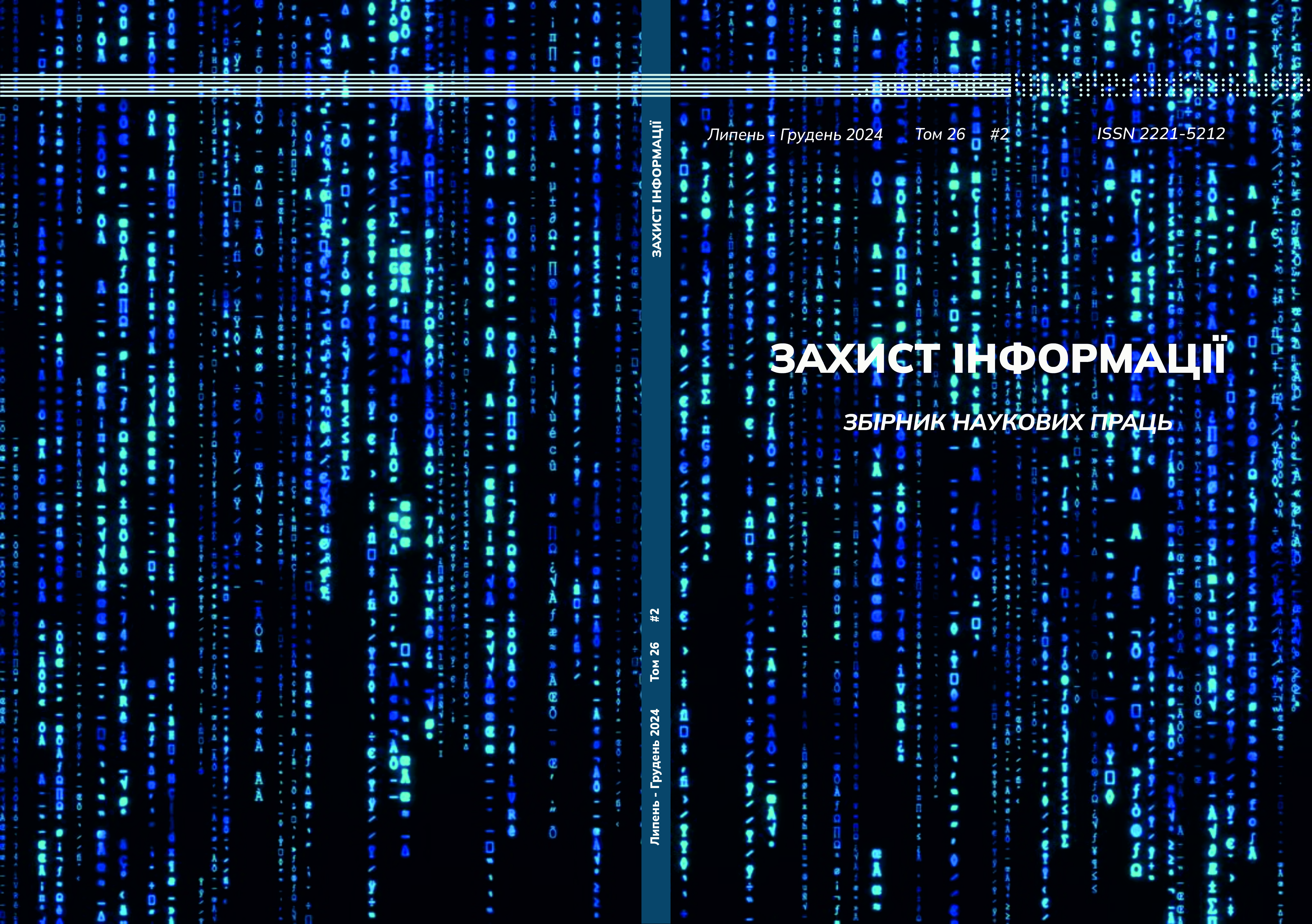СИСТЕМА РЕАЛІЗАЦІЇ ЗАХИСТУ СЕРВЕРІВ З УРАХУВАННЯМ АНОМАЛІЙ В ПАКЕТАХ
DOI:
https://doi.org/10.18372/2410-7840.26.20018Ключові слова:
аномалії в пакетах, DDoS-атаки, машинне навчання, аналіз трафіку, захист серверівАнотація
У сучасних умовах зростання кіберзагроз захист серверів стає критично важливим аспектом інформаційної безпеки, особливо в контексті збільшення обсягів мережевого трафіку та складності атак. Одним із ефективних підходів є використання систем захисту, що враховують аномалії у мережевих пакетах. Виявлення та обробка таких аномалій дозволяють оперативно ідентифікувати та нейтралізувати загрози, серед яких особливе місце займають DDoS-атаки. У статті розглянуто методи аналізу мережевого трафіку в реальному часі, що базуються на статистичних методах, а також алгоритмах машинного навчання для класифікації мережевих пакетів за їх поведінковими характеристиками [1]. Представлена система реалізує багаторівневий підхід до захисту серверів, який включає три основні етапи: первинну фільтрацію даних, статистичний аналіз та використання моделей машинного навчання. На першому етапі відсіюються шкідливі пакети на основі простих критеріїв, таких як заборонені IP-адреси або некоректний формат пакетів [2]. На другому етапі застосовується статистичний аналіз для виявлення відхилень у розподілі трафіку, наприклад, раптове збільшення кількості запитів або зміну розміру пакетів [3]. Третій етап передбачає застосування класифікаторів, які навчаються на історичних даних для визначення аномалій у поведінці мережі. Перелік представлених моделей дозволяє адаптуватися до нових типів атак шляхом автоматичного оновлення [4]. Наведемо переваги представленої системи: виявляє як традиційні DDoS-атаки (сканування портів, експлуатація вразливостей мережевих протоколів та спроби ін’єкцій SQL-запитів), так і інші види загроз. По-друге, її інтеграція з існуючими інструментами моніторингу та фаєрволами. Також забезпечує простоту впровадження без значного збільшення витрат завдяки інтеграції з існуючими інструментами моніторингу та фаєрволами [5]. Система відзначається високою точністю виявлення атак, низьким рівнем хибно-позитивних спрацьовувань. Та забезпечує ефективний захист серверів у реальному часі для забезпечення безперервності бізнес-процесів та запобігання фінансовим і репутаційним втратам.
Посилання
Yu S., Lu X., Zhu Y. Traffic Classification Techniques in Network Security. – Springer, 2022.
Behal S., Kumar K. Detection of DDoS Attacks Using Machine Learning Algorithms. // International Journal of Computer Applications, 2020.
Akbanov M., Koucheryavy A. Adaptive Anomaly Detection for Cybersecurity. – Wiley, 2021.
Jain R., Agrawal R. Network Intrusion Detection Systems: A Machine Learning Perspective. // Computers & Security, 2019.
Wang P., Gu G. Real-Time Traffic Anomaly Detection Using Hybrid Approaches. // Journal of Network Security, 2020.
Using the Latest Methods of Cluster Analysis to Identify Similar Profiles in Leading Social Networks. / Bohdan Zhurakovskyi, Ihor Averichev and Ivan Shakhmatov // Information Technology and Implementation (Satellite) Conference Proceedings, 21 November, 2023. – С.116-126.
Doriguzzi-Corin R., Millar S., Scott-Hayward S. Dataset-Driven DDoS Attack Detection Using Neural Networks // IEEE Transactions on Network and Service Management, 2021.
Zargar S. T., Joshi J., Tipper D. A Survey of Defense Mechanisms Against Distributed Denial of Service (DDoS) Flooding Attacks // IEEE Communications Surveys & Tutorials, 2020.
Miao Y., Gong Z., Zhou W. Machine Learning-Based DDoS Detection and Mitigation in SDN Environments. – Elsevier, 2022.
Radovanović M., Filipović N. Deep Learning Techniques for Anomaly Detection in Network Traffic. // IEEE Access, 2021.
Abawajy J., Hassan M. RNN-Based Approaches for Early DDoS Detection. – Elsevier, 2022.
Kaur J., Kumar V. Unsupervised Anomaly Detection Using Clustering Techniques // Journal of Network Security, 2021.
Sharma S., Gupta P. Frequency-Based Filtering Methods for DDoS Attack Prevention. // International Journal of Computer Applications, 2020.
Liu H., Zhang Y. Hybrid Filtering Techniques for Anomaly Detection in High-Volume Traffic // Computers & Security, 2022.
Park K., Kim S. Integrated Multi-Layer Network Defense Against DDoS. – Springer, 2021.
Zhu Y., Chen L. Adaptive Filtering and Anomaly Detection in Real-Time Systems // IEEE Transactions on Information Forensics and Security, 2023.
Стефурак О.Р., Тихонов Ю.О., Лаптєв О.А., Зозуля С.А. Удосконалення стохастичної моделі з метою визначення загроз пошкодження або несанкціонованого витоку інформації // Сучасний захист інформації, 2020. – № 2(42). – С.19-26.
Пепа Ю.В., Хорошко В.О., Хохлачова Ю.Є., Аль-Далваш А. Методика аналізу та оцінки захищеності систем захисту інформації з урахуванням ступеня перекриття загроз // Сучасний захист інформації, 2024. – № 1(57). – С.69-76.
Опанасенко М.І., Поночовний П.М. Технологія забезпечення кібербезпеки хмарного середовища на базі рішення Cisco Cloudlock // Сучасний захист інформації, 2023. – № 1(53). – С.72-78.
Хорошко В.О., Лаптєв О.А., Хохлачева Ю.Є., Аль-далваш Аблуллах Фоуад, Пепа Ю.В. Особливості проектування захищених інформаційних мереж. Наукоємні технології. 2024.Том 62. № 2 . С.154-163 https://doi.org/10.18372/2310-5461.62.18709
Дробик О. В., Лаптєв О. А., Пархоменко І. І., Богуславська О. В., Пепа Ю. В., Пономаренко В. В. Розпізнавання радіосигналів на основі апроксимації спектральної функції у базисі передатних функцій резонансних ланок другого порядку. Сучасний захист інформації. 2024. №2. С.13-23. https://doi.org/ 10.31673/2409-7292.2024. 020002

##submission.downloads##
Опубліковано
Номер
Розділ
Ліцензія
Автори, які публікуються у цьому журналі, погоджуються з наступними умовами:- Автори залишають за собою право на авторство своєї роботи та передають журналу право першої публікації цієї роботи на умовах ліцензії Creative Commons Attribution License, котра дозволяє іншим особам вільно розповсюджувати опубліковану роботу з обов'язковим посиланням на авторів оригінальної роботи та першу публікацію роботи у цьому журналі.
- Автори мають право укладати самостійні додаткові угоди щодо неексклюзивного розповсюдження роботи у тому вигляді, в якому вона була опублікована цим журналом (наприклад, розміщувати роботу в електронному сховищі установи або публікувати у складі монографії), за умови збереження посилання на першу публікацію роботи у цьому журналі.
- Політика журналу дозволяє і заохочує розміщення авторами в мережі Інтернет (наприклад, у сховищах установ або на особистих веб-сайтах) рукопису роботи, як до подання цього рукопису до редакції, так і під час його редакційного опрацювання, оскільки це сприяє виникненню продуктивної наукової дискусії та позитивно позначається на оперативності та динаміці цитування опублікованої роботи (див. The Effect of Open Access).
